Not so easy to say, but very easy to enjoy once there.
Houtman Abrolhos. Probably better known as just the Abrolhos Islands, are renowned for their stunning coral reefs, abundant marine life, and rich historical significance. Quite literally they are often referred to as the Galapagos Islands of the Indian Ocean. Now there’s a rap, or even more like, the sound of rapturous applause.
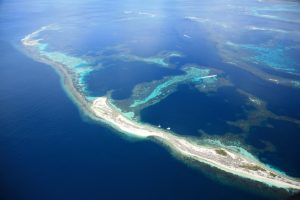
So, the word Abrolhos is derived from the Portuguese ‘abri vossos olhos’, which is translated as ‘open your eyes – keep a good watch’. Yes. Now we get it. They are low, sort of in the middle of nowhere, and plenty of mariners have slammed into them. In 1619, the Dutch navigator, Frederick de Houtman, called them such when he discovered them, and clearly lived to tell the tale.
This remote and beautiful archipelago is located 60 kilometres west of Geraldton on the coast of Western Australia. Extending 100 kilometres north to south, the Abrolhos are made up of 122 islands grouped into three main clusters: Wallabi (correct spelling in this application), Easter, and Pelsaert.
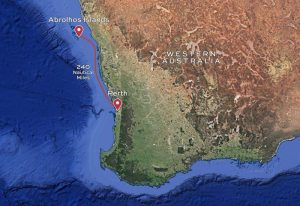
David Crothers has travelled the WA coastline for most of his life with his family and friends exploring from Mandurah, right up to the Kimberley. “In the summer months we regularly go to Rottnest, and then also Mandurah. We have gone to Dunsborough once, as well. During the winter months, we head to the Abrolhos Islands, making eight or nine trips from the end of April to August. It’s just fantastic. The water’s crystal clear, the fish are abundant, and the bird life is unbelievable. It is one of our favourite places to visit.”
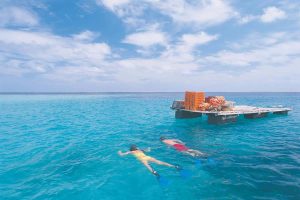
The warm waters of the Leeuwin Current create a perfect environment for both temperate and tropical marine life to thrive. The coral reefs are part of the Houtman Abrolhos Marine Park, and with over 190 different types of coral and countless species of tropical fish, snorkelling and/or diving in the area are an absolute must.
Some of the marine life include Baldchin groper, Coral Trout, Dhufish, Dolphins, Sea Turtles, and importantly, the endangered Australian Sea Lion. Migrating Humpback whales are often seen frolicking in the waters between July and September as they call into the islands for a bit of a break.
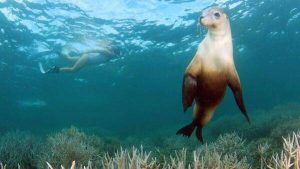
While Exmouth regularly ranks in the top five destinations to fish in Australia, David believes that, “The Abrolhos Islands are even better, and you don’t have to travel the extra three of four days to get there.” The Abrolhos have huge variety fish available including the above plus Yellowfish Tuna, Spanish and Shark Mackerel, Yellowtail Kingfish, Cod and Pink Snapper. David and his family also enjoy being able to put their pots in and pull out the crayfish, considered one of the area’s local delicacies. As David says of the latter, which is one of his all-time favourites, “It doesn’t get much better than that!”
In addition to the abundance of rich marine life that can be found in these pristine turquoise waters, the Abrolhos Islands are the breeding site for over two million sea birds ranging across 35 species including Noddies, Shearwaters, and Terns. The islands are also home to over 140 species of native flora including Pink Heath and Saltbush, as well as rare fauna like the Tammar Wallaby.
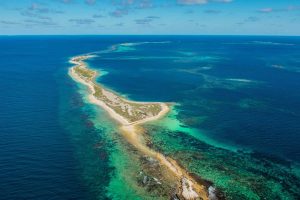
Not surprisingly, this remote and rugged area is also rich in maritime history, given its path in the way of the Dutch East Indies trade routes. It is often referred to as the “Graveyard of Ships”, as there is thought to be over 50 vessels wrecked in the area. The most famous of which is the Batavia. She ran aground in 1629 on her maiden voyage from Holland following a mutiny onboard. This 400-year-old shipwreck is considered one of WA’s best dive spots to explore, and of course is part of a deep cultural significance to Australia’s development.
The Abrolhos Islands are considered a remote offshore location, so you will need to make sure you are well equipped. “There’s no shopping over there, it’s very primitive, so you’ve got to be self-sufficient and our Maritimo M55 is perfect for this type of cruising”, said David. You have to both bring it all with you in the first place, and then take it away when you go. “There is plenty of storage, especially in the lazarette is amazing for storage. We have water making facilities, refrigeration, remote communications, navigation instruments, waste-disposal storage and importantly plenty of room for guests, because they all want to come with you!”
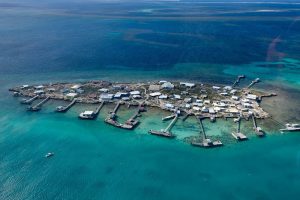
David suggests, “A minimum of a two-night stay is required, but the ultimate is to go for a week. I sit on around 22, 23 knots on the way over, and it takes about an hour and three quarters to reach the North Island and an hour to reach the South Island from Geraldton. People just love it. You just sit out at the back of the boat, in the middle of the ocean and enjoy the seafood and stunning location.”
Quite a few people make the 201nm trip from Perth and to Geraldton, leaving their boats there so they can come and go across to the islands during the winter months, and spend time at this stunning location. Geraldton’s got all you’ll need in terms of supplies. For those who have time restrictions and need to back for work you are able to fly in and out of the Abrolhos from Geraldton.
You will need to submit an application form to the Department of Fisheries of your intention to visit the island before you go. The Abrolhos are fairly low and flat, so navigation can be challenging. Accordingly, it is recommended that you arrive with plenty of light, have good technology on board, and many sets of eyes to assist. Once inside the reefs you will find the lagoons are calm, but there is often a level of wind around.
There are a limited number of public moorings available within each of the groups that provide shelter from the wind and swell in different weather conditions. These moorings are designed for vessels up to 25 meters in length and 40 tons in weight. Please note that these cannot be booked in advance. When moorings are not available it is recommended to anchor in areas of sand or mud, making sure you avoid reefs and seagrass areas, thereby not damaging these sensitive areas.
David concluded by saying, “The Abrolhos Islands are not tropical islands like you find in Queensland. It is just a magnificent place for fishing, bird watching, and having a good time with family and friends.”







